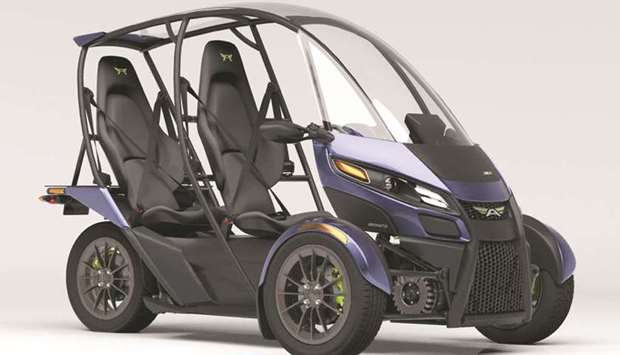For those who subscribe to a less-is-more aesthetic, this electric vehicle may be a high point of auto design. It’s going to become either a prophecy of the weirder future of urban transportation or an anaemic, goofy-looking golf cart looked back on as a joke.
Arcimoto Inc chief executive officer Mark Frohnmayer, an engineer who made his fortune in video games, is betting that the cars of tomorrow won’t always resemble those of the present. “To me, this is the sweet spot between the motorcycle and the car,” he said. “It’s perfect for 85% of our daily trips — going to get coffee, going to work, going to the gym, you name it.”
You might not want to own an Arcimoto — that’s OK by Frohnmayer — but the idea is that you might not need to. The concept of owning a vehicle is quickly starting to look passé as ride-hailing and car-sharing fleets expand. Arcimoto and its ilk of differently designed cars invite us to imagine that this trend will continue to free drivers from the pressure of finding one vehicle that can do it all. Instead, the theory goes, we might choose a car to fit the mission of the day. And maybe that car will need to be just big enough to complete a short trip.
A shift in ownership patterns could bring about a step change in automotive evolution that opens space for odd critters like the Arcimoto. Biologists call this punctuated equilibrium: Everything in an ecosystem seems pretty much the same for quite a while, and then suddenly there’s a new species.
In the case of the tiny, squirrel-like cars, there are a few popping up. A crowd of engineers has rolled out itty-bitty designs at other startups, motorcycle makers and even the skunkworks of automotive giants Renault SA and Toyota Motor Corp US drivers are deep in the grip of SUV fever at the moment, but that doesn’t mean there won’t be a role for these minimalist cars.
Consider Marseilles, France, where public transport operator Keolis SA runs a system that costs €50 ($57) a month and comprises a range of options, from rail to ride-hailing to shared bikes. “I’m a big fan of these ultrasmall vehicles,” said Andreas Mai, executive vice president for market development at Keolis. “It’s all part of a scalable transportation system.”
In Detroit, May Mobility Inc is ferrying workers in six-person driverless shuttles that carry passengers on predetermined routes. Zafar Razzacki, the startup’s product chief, said a two-person pod might work even better in certain situations, such as getting across a college campus or shuttling to an airport parking lot. “I’m a believer in the multimodal future, depending on your particular use case,” Razzacki said. “I don’t think anyone would have envisioned scooter-sharing would be a $1bn market, so I think there’s a lot of space for this market to develop.”
There’s compelling evidence that the age of auto ownership, while not ending, is steadily declining. Goldman Sachs Group Inc predicts that ride-hailing and car-sharing networks, in total, will be a $285bn business by 2030. That kind of market share eventually has to eat into private car ownership.
What’s it like to drive in a minimalist car? The Arcimoto turns heads in traffic-clogged Manhattan, making the silent crawling crosstown in the pod something like a 5-mile-per-hour press conference. The questions come from all comers on all corners. “We call it ‘parketing,’” Frohnmayer said. “You park them,
and they market themselves.”
Driving the thing is a giddy experience. Two electric motors linked to the front wheels have enough power to reach 80mph. With the low centre of gravity common to all vehicles powered by a big, heavy battery, the Arcimoto careens around corners with little drama and can travel as far as 130 miles on one charge.
The ultracompact size means that when Frohnmayer makes the rounds in New York, he never parks more than half a block from where he wants to go. On a recent trip a traffic cop, no doubt familiar with the challenges of legal parking, inquired about where to order an Acrimoto.
“The only people who don’t get it are the ones who overthink it,” said Arcimoto Vice President Jesse Fittipaldi. “Children understand it immediately — and, for some reason, homeless people.”
It’s easy to overthink it, however, on a rainy day in gridlock. Doors would be nice, though apparently the startup is working on a version with this feature. The throttle is touchy, with little subtlety between a slow roll and a sprint. There’s a similar harshness in the regenerative braking, which charges the battery while slowing the vehicle. Between the two systems, a rookie can spend much of the trip lurching forward and back in the seat like a teenager learning to drive stick.
The promise of these minimalist vehicles hangs on their ability to do an end run around traffic. That might be the biggest problem, since the Arcimoto is still too wide to split lanes in most Manhattan streets. And, more critically, Arcimoto drivers would need a motorcycle license in 39 states, at least as regulations stand now.
At $15,000, the price is not nearly as spartan as its design. A similar-size chunk of money fetches a midrange Harley-Davidson or a Fiat 500 with a backup camera and seven air bags.
Japanese drivers, in particular, may find the Arcimoto overly expensive. Every year, they buy almost 2mn “kei” cars, which are by law shorter than 12 feet. These minimachines are tooled for Tokyo’s tight spaces and yet still packed with the amenities of a traditional car.

